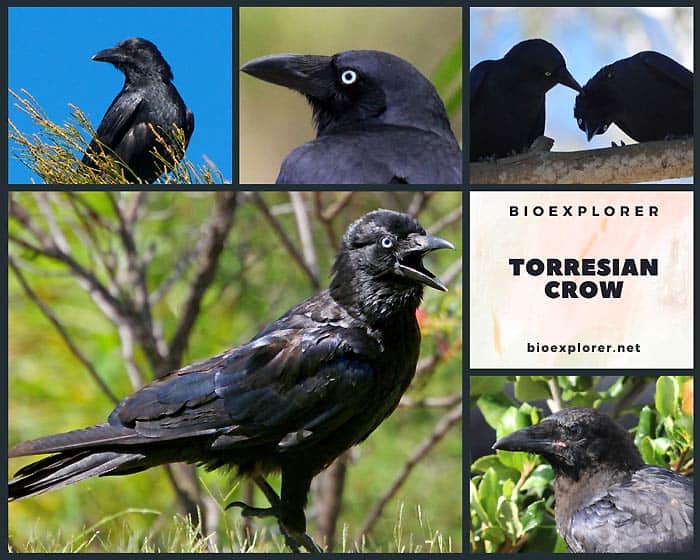
| Animalia | Passeriformes | Corvidae | Corvus | Corvus orru |
The Torresian crow (Corvus orru), or the Papuan crow or Australian crow, is a highly adaptable and intelligent member of the crow family across northern and western Australia and parts of Indonesia and Papua New Guinea.
Renowned for its glossy black plumage and distinctive white eyes, this species is one of the most adaptable types of crows, thriving in various habitats—from tropical rainforests and woodlands to urban environments and farmlands. Among the types of birds found in Australia, its remarkable ability to exploit diverse food sources and environments has contributed to its widespread presence and success, particularly in human-altered landscapes.
The Torresian crow’s intelligence, social behavior, and adaptability make it a fascinating subject for ornithologists and casual birdwatchers.
Table of Contents
- Torresian Crow Characteristics
- Torresian Crow Habitat
- Diet and Hunting Behavior
- Breeding Behavior
- Interactions with Other Wildlife
- Ecological Importance
- Torresian Crow Fun Facts
- Frequently Asked Questions
- Why are Torresian crows sometimes called “Papuan crows”?
- Are Torresian crows found in southern Australia?
- How do Torresian crows cope with dry conditions?
- Do Torresian crows migrate seasonally?
- What is the significance of the crow’s white eye?
- Can Torresian crows be found on islands?
- What’s the main threat to Torresian crows?
- How do Torresian crows interact with humans in urban areas?
- Is the Torresian crow’s population increasing or decreasing?
- Common Name(s): Australian crow, Papuan crow.
- Family: Corvidae
- Body Dimensions: 17-inch body length, 30-inch wingspan.
- Male Plumage Colors: Glossy black, iridescent sheen.
- Female Plumage Colors: Glossy black, iridescent sheen.
- Habitat: Woodlands, rainforests, urban areas.
- Diet: Fruits, different types of insects, carrion.
- Native Countries: Australia, Papua New Guinea, Indonesia.
- Continents: Oceania and Asia.
Torresian Crow Characteristics
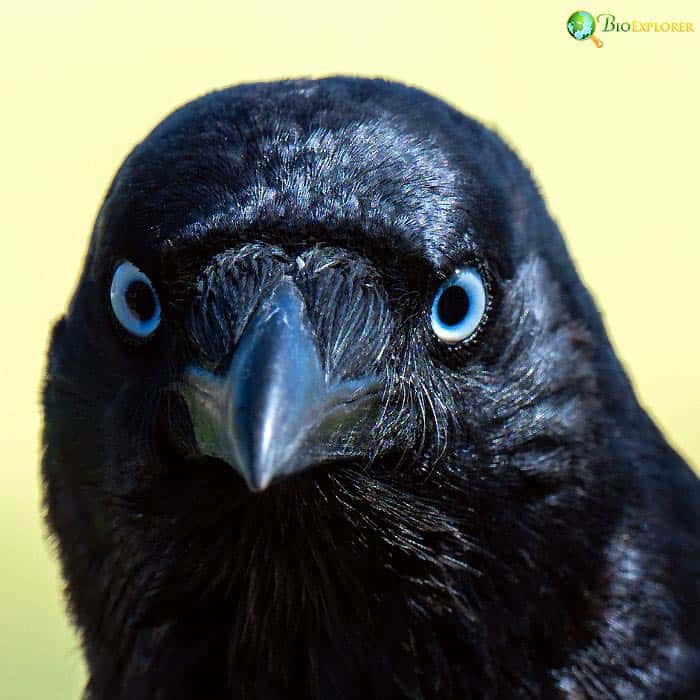
- The Torresian crow is a robust, medium-to-large passerine bird characterized by its sleek, all-black plumage covering its body, beak, and mouth. Its most striking feature is its white irises, which stand out against the dark feathers.
- Juvenile crows have blue eyes that gradually change to white by about 9 months of age. The base of the feathers on the head and neck is white, a detail that becomes visible when the feathers are ruffled.
- Both males and females appear identical, sporting glossy black feathers on their backs and slightly duller black on the breast. The tail is broad with a square tip, and the bill is dark grey, roughly matching the length of the head.
- The legs and feet are also grey, with a hint of pink on the soles. Compared to the similar little crow, the Torresian crow is slightly larger and has a more formidable bill.
- Upon landing, the Torresian crow often performs a characteristic wing shuffle. Juveniles can be distinguished from adults not only by their eye color but also by their lack of glossy dorsal feathers.
- These physical traits, combined with their distinctive calls (which are often described as a nasal, metallic “uk-uk-uk-uk-uk” or “ok-ok-ok-ok“), help differentiate them from other Australian corvids.
Torresian Crow Habitat
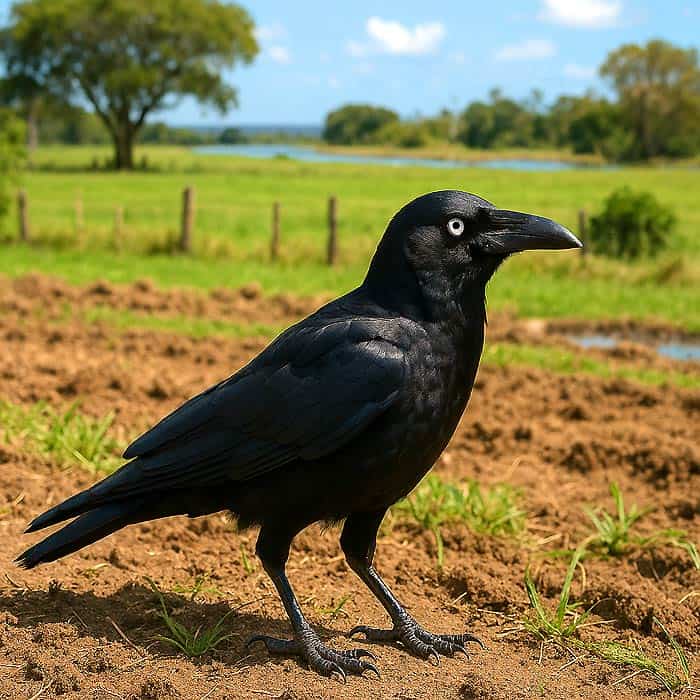
The Torresian crow is a versatile inhabitant, occupying a broad range of environments as long as a permanent water source is available. Its natural habitats include tropical rainforests, eucalyptus woodlands, open scrublands, beaches, and swamps. The species has also shown remarkable adaptability to human-modified landscapes, thriving in farmlands, towns, and cities.
Geographically, the Torresian crow is found throughout the north and west of Australia, with populations extending to nearby islands in Indonesia and Papua New Guinea.
It is particularly abundant on farms in Northern Australia, where it is sometimes regarded as a pest due to its opportunistic feeding habits. This adaptability to various environments has played a key role in the species’ success and widespread distribution.
Diet and Hunting Behavior
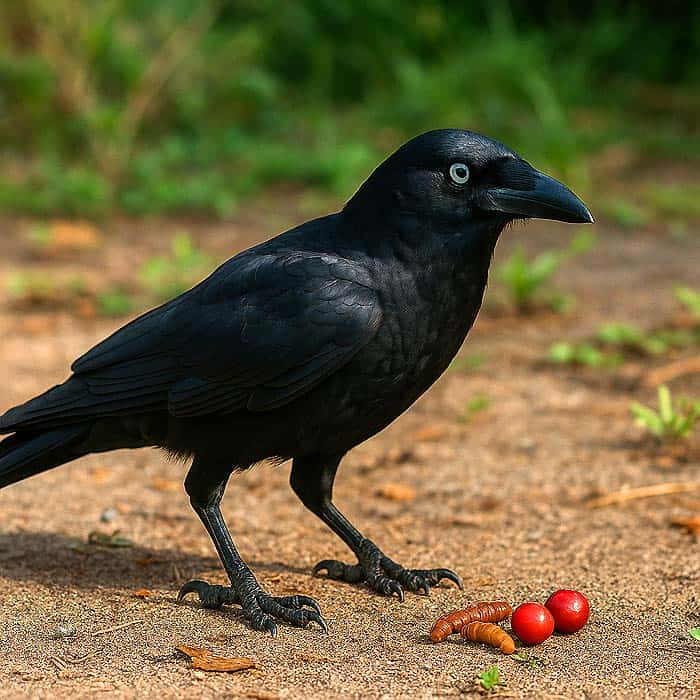
The Torresian crow is an omnivorous and opportunistic feeder, consuming various food items.
Its diet includes invertebrates, berries, carrion, and, in urban areas, human-generated waste. This flexibility allows the crow to thrive in both natural and urban settings.
One of the most remarkable aspects of its feeding behavior is its ability to safely consume the poisonous cane toad. For instance, Torresian crows in northern Australia have developed a unique technique for avoiding the toxic parts of this invasive species. This skill is culturally transmitted within the population. This demonstrates the crow’s intelligence and capacity for learning.
Torresian crows are also known for their aggressive and territorial behavior, especially females, who defend their feeding areas against larger birds of prey. They often form large, nomadic groups that roam across landscapes for food. Still, during the breeding season, they establish temporary territories.
Their vocalizations, distinct from those of the Australian raven, play a role in communication and territorial defense.
Breeding Behavior
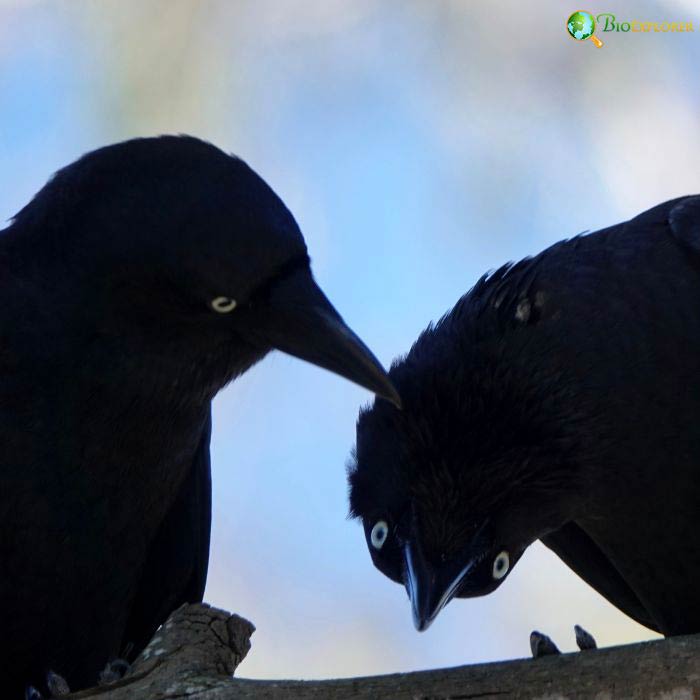
The breeding season for the Torresian crow peaks from August to January. During this period, pairs establish territories and build nests, typically high in different types of trees or occasionally on man-made structures. The nest is constructed from sticks and lined with softer materials to provide a secure environment for the eggs and chicks.
- The female lays between 2 and 4 eggs and incubates them over about 20 days. Once the eggs hatch, both parents participate in rearing the chicks, providing them with food and protection. The chicks remain in the nest for approximately forty days before they fledge and begin to explore their surroundings.
- Torresian crows exhibit strong parental care and social bonds during the breeding season. The family remains together for some time after fleeing, with the young learning essential survival skills from their parents. This period of extended care and learning is crucial for the development of the chicks, particularly in acquiring foraging techniques and social behaviors.
The species’ adaptability extends to its nesting choices, with some pairs utilizing urban structures when natural sites are unavailable. This flexibility, combined with their intelligence and cooperative breeding strategies, contributes to the Torresian crow’s reproductive success across its range.
Interactions with Other Wildlife
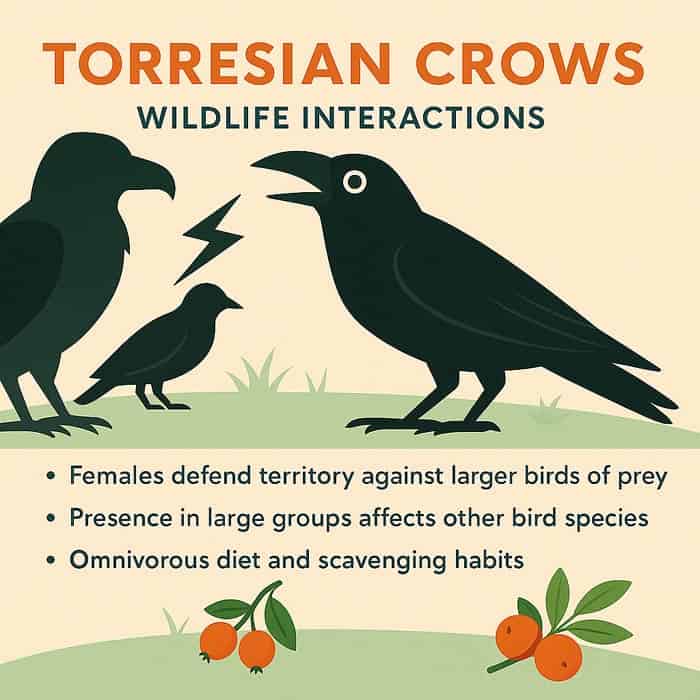
Torresian crows are known for their assertive and sometimes aggressive interactions with other wildlife. Females, in particular, are noted for defending their territory against larger birds of prey, demonstrating the species’ boldness and resourcefulness. The crows’ presence in large, nomadic groups can also influence the behavior and distribution of other bird species within their habitat.
Their omnivorous diet and scavenging habits mean they often come into contact with various animals, from insects and small vertebrates to larger scavengers. In agricultural areas, their reputation as pests sometimes brings them into conflict with humans and livestock. However, their role as scavengers also contributes to the ecosystem by helping to clean up carrion and waste.
Ecological Importance
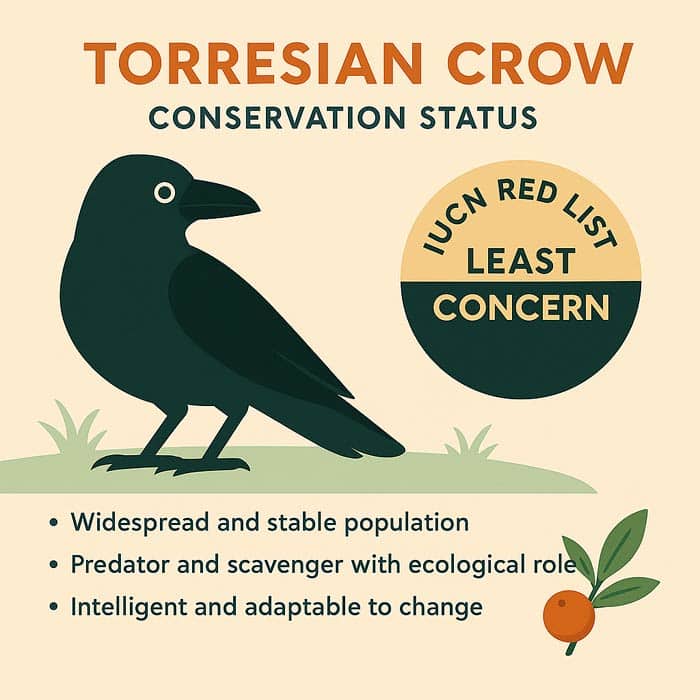
The Torresian crow is listed as Least Concern on the IUCN Red List, indicating that it is not at immediate risk of population decline or habitat loss. Its adaptability to a wide range of environments, including urban and agricultural landscapes, has enabled the species to maintain stable and, in some areas, increasing populations.
Despite being considered a pest in some regions due to its opportunistic feeding habits, the Torresian crow plays a vital ecological role as a predator and scavenger. By consuming carrion, waste, and a variety of invertebrates, the species helps to maintain environmental balance and reduce the spread of disease.
The crow’s intelligence and ability to adapt to changing environments make it an important species for studying avian behavior and urban ecology. Its success in natural and human-modified landscapes highlights the significance of behavioral flexibility in wildlife conservation.
Torresian Crow Fun Facts
- Both sexes of this species look alike, making it difficult to distinguish males from females in the field with the naked eye.
- Juvenile crows have blue eyes that turn white as they mature, usually by nine months.
- The base of the feathers on the head and neck is white, visible when the feathers are ruffled.
- Torresian crows are known for their intelligence and can learn complex behaviors, such as safely eating poisonous cane toads by avoiding the toxic parts. (Explore what do toads eat here).
- The species is highly adaptable, thriving in urban areas, farmlands, and various natural habitats.
- Upon landing, the crow often performs a characteristic wing shuffle.
- Females are particularly aggressive in defending their territory, even against larger birds of prey.
Frequently Asked Questions
Why are Torresian crows sometimes called “Papuan crows”?
Since their range extends beyond Australia into Papua New Guinea, they are commonly called Papuan crows.
Are Torresian crows found in southern Australia?
No, their natural range is limited to northern and western Australia; they are absent from the cooler southern regions.
How do Torresian crows cope with dry conditions?
They require a permanent water source in their habitat, so they are most commonly found in areas where water is reliably available, even in otherwise arid regions.
Do Torresian crows migrate seasonally?
The sources indicate that Torresian crows are generally resident. Still, some local movement may occur in response to food and water availability.
What is the significance of the crow’s white eye?
The white iris of the adult Torresian crow is a key field mark for birdwatchers. It helps distinguish it from other Australian crows and ravens.
Can Torresian crows be found on islands?
Yes, they are on several islands off the northern Australian coast, as well as in parts of Indonesia and Papua New Guinea.
What’s the main threat to Torresian crows?
According to the IUCN, there are currently no major threats to the species; its population is stable and widespread.
How do Torresian crows interact with humans in urban areas?
They are highly adaptable and often thrive in towns and cities, sometimes considered a nuisance due to their scavenging habits.
Is the Torresian crow’s population increasing or decreasing?
The population is stable and, in some areas, may even be increasing due to adaptation to human-modified landscapes.
The Torresian crow is one of Australia’s most adaptable and intelligent bird species.
Its ability to thrive in various habitats, from remote rainforests to bustling urban centers, is a testament to its behavioral flexibility and resourcefulness. With its striking appearance, distinctive calls, and complex social behaviors, the Torresian crow captivates bird enthusiasts and researchers alike.
While sometimes considered a pest in agricultural settings, its ecological role as a scavenger and predator is invaluable. The species’ stable conservation status further highlights its success in a rapidly changing world, making the Torresian crow a fascinating subject for ongoing study and appreciation.
![]()











